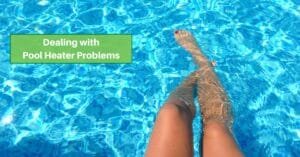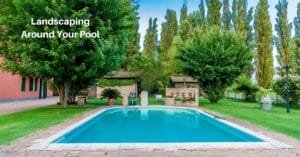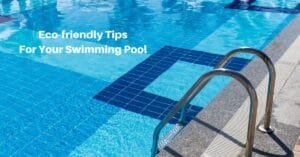Brushing and scrubbing your pool is probably not the first thing that comes to mind when you think of pool maintenance. Sure, testing the water, adding chlorine, skimming out some leaves – they’re at the top of the list. But routine brushing and scrubbing is one of the most important things you can do to keep your pool healthy, safe, and looking great.
The main benefit of regular brushing is that it helps keep algae from growing in your pool. Algae spores are constantly being introduced into your pool—by wind, rain, or even on the skin and hair of swimmers. If these spores settle on surfaces that don’t get disturbed, they can start to grow, especially in warm, poorly circulated water. Once algae gets a foothold, it’s a pain to get rid of. But if you regularly brush your pool – especially areas where the water doesn’t move as much – you’re removing the chance for the algae to gain a foothold.
Dust, pollen, oils, and calcium buildup can also cling to the sides of your pool. Over time, these can stain plaster and tile, leaving your pool looking dull or dirty even when the water is chemically balanced. Regular brushing breaks up these deposits and prevents them from becoming permanent fixtures.
Another reason to brush your pool is that it helps your chemicals do their job more effectively. When debris or grime clings to surfaces, it can create a barrier that chlorine and other sanitizers can’t fully penetrate. By scrubbing away this film, you’re helping those sanitizers reach all the spots where bacteria might be hiding. This means your pool stays cleaner with less chemical usage. You won’t need to waste money trying to “shock” a pool that just needs a good brushing.
Brushing and scrubbing helps your filtration system remove all this debris, too. When this gunk builds up on pool surfaces and is left alone, it just stays there. But when you brush it off, you help that debris enter the water column, where it can be caught and removed. That means less sticks to your walls and more of it ending up in the filter, where it belongs.
Finally, brushing your pool just makes it look better. A well-brushed pool has brighter, cleaner-looking surfaces, clearer water, and a more inviting feel. It’s a small investment of time for a big return in visual appeal—especially if you’re entertaining guests or spending a lot of time poolside.
Trouble Spots: Where You Really Need to Brush
To brush your pool effectively, where you brush matters just as much as how often you brush. There are spots in every pool that tend to collect debris, algae, and scale more easily than others—and they often go unnoticed until a problem pops up.
We all remember to cover the pool floor and walls. These are the main surfaces, and if they’re left unbrushed for too long, they can quickly develop a slick, slippery feel from the beginning stages of algae growth. Brushing these surfaces helps keep buildup from developing into more serious issues.
Use a long-handled brush with bristles appropriate for your pool type. Nylon should be used on vinyl or fiberglass, or stainless steel for concrete or plaster. Push debris toward the main drain where your filtration system can catch it.
But don’t overlook less obvious areas like these:
- Corners and crevices are prime spots for algae. These sections of your pool don’t see as much water circulation, meaning sanitizing chemicals don’t reach them as effectively. Be thorough with steps, ladders, and the seams where walls meet the floor. Anywhere there’s a nook or shadow, algae is more likely to develop.
- Behind pool ladders and around stairs is another common trouble zone. Because these areas are hard to see, they’re often overlooked. But the still water and low sunlight make them ideal for algae growth. If you can remove ladders to scrub behind them, do it—otherwise, get in there as best you can with a smaller brush.
- Tile lines and water lines can accumulate a greasy film of sunscreen, body oils, and minerals that stick just above the surface. This buildup is ugly and can stain tiles over time. A weekly scrub with a tile brush and a non-abrasive cleaner can prevent this from becoming a tough chore down the road.
- Around skimmers and return jets, you’ll find all kinds of buildup. These areas see a lot of flow and contact, so they’re magnets for scale and grime. A few quick swipes with your brush will keep things moving smoothly.
- Steps and benches in pools with built-in features like tanning ledges or swim-outs can collect sand, dirt, and debris that settle easily in still water. These flat surfaces don’t get stirred up much by swimmers or circulation, so brushing them ensures they stay clean and slip-free.
Brushing your pool is a bit like brushing your teeth. If you’re doing it right, you’re not just doing a quick pass. You want to go over every surface, hit the corners, and pay extra attention to problem areas. By consistently brushing the entire pool, you’ll extend the life of your pool finish, improve water quality, and prevent the most common maintenance headaches.
Tools and Techniques: Making the Job Easier and More Effective
Brushing your pool doesn’t need to be a chore you dread. Like any regular maintenance task, using the right tools makes all the difference. And choosing the right tools depends on your pool materials.
- For concrete or gunite pools, go with a stainless steel or mixed bristle brush. These surfaces are tough and porous, and they benefit from a more aggressive scrub.
- For vinyl or fiberglass pools, use a soft nylon brush to avoid scratching or tearing the liner.
- Some brushes are made for specific jobs. There are tile line brushes with stiffer bristles, corner brushes with angled heads, or hand-held scrubbers for spot cleaning. A well-rounded pool maintenance kit often includes a few types of brushes.
Next, consider your pole. A sturdy telescoping pole is a must. Look for one that feels solid, extends easily, and locks securely in place. Many poles are made of aluminum for lightness and rust resistance. A good pole can serve double duty for brushing, skimming, and vacuuming attachments.
Now for the technique. Brushing isn’t just about random sweeping; you should follow a system:
- Start at the shallow end and work your way toward the deep end. This helps move loosened debris toward your pool’s main drain, where your filtration system can handle it.
- Use long, overlapping strokes and keep consistent pressure. If you’re just skimming the surface, you’re not really getting the job done.
- For vertical surfaces (walls), push the brush upward first, then pull it down with more pressure. Algae and dirt tend to cling better on the downstroke, so reversing the direction can help break it up.
- Be intentional around your return jets. Brush toward them to help so the debris doesn’t just resettle where you started.
- Don’t forget to brush after shocking the pool. Of course, you shouldn’t enter the pool for about 24 hours, but you can use your pole to do the main areas, and after the wait, there’s still plenty of time for the finer details. Algae may come off more easily when weakened by chlorine; brushing helps prevent it from clinging or coming back. If you’re treating an algae bloom, brush daily until it’s fully cleared.
If you’re finding brushing to be time-consuming, there are also time-saving tools worth looking into:
- Brush-vacuum heads that combine brushing with suction help you tackle two tasks at once.
- Robotic pool cleaners don’t fully replace brushing, but high-end models with scrubber brushes can handle daily upkeep and keep algae from gaining a foothold.
- Wall-climbing robots can reduce how often you need to manually brush, but you’ll still want to hit corners, steps, and behind ladders manually from time to time.
Don’t overlook the importance of consistency. Even the best equipment can’t compensate for infrequent cleaning. Adding brushing to your weekly pool care schedule is the real game-changer. It keeps your pool looking its best and saves you headaches and expenses down the road.
Making Brushing Part of Your Long-Term Pool Care Routine
A good rule of thumb is to brush at least once a week during the swimming season. But you will need to do it more often if you’re experiencing issues like algae blooms or pollen buildup. When the pool is getting heavy use, after storms, after shocking your pool, or any time you notice cloudy water forming are also important times to brush.
In cooler seasons or when your pool isn’t in use, you should still brush. Even if your pool is covered, dust, spores, and fine debris can make their way in. Give your pool a light brushing before closing for the winter and again during the off-season if conditions allow. This can prevent staining and buildup that would otherwise greet you in spring.
Even if the pool water looks fine, you should still brush the pool. Water clarity doesn’t tell the full story. Algae can start forming in places you don’t always notice, and of course it starts so small that you wouldn’t notice it, anyway.
Brushing can also help in balancing your pool chemistry. When you scrub surfaces, you’re helping distribute chemicals more evenly. This ensures that sanitizers like chlorine don’t get used up faster in certain areas and ignored in others.
The time you spend on this chore is also a great opportunity for routine inspection. While brushing, you’re naturally getting a close-up look at your pool walls, steps, tile line, and corners. You’ll be more likely to catch small cracks, stains, or loose tiles before they become expensive problems. It keeps you in tune with the condition of your pool and gives you a little peace of mind.
There’s no flashy shortcut to brushing—it’s about consistency, technique, and using the right tools. But the reward is a clean, healthy, and long-lasting pool that looks great and stays safe for your family and guests. It might only take 15 to 30 minutes out of your week, but that small investment of time pays off in fewer problems and more carefree swim days.
So next time you head outside with your pool brush in hand, remember: your cleaning is protecting your investment, extending the life of your pool, and ensuring it’s always ready to enjoy. And that’s time well spent.









